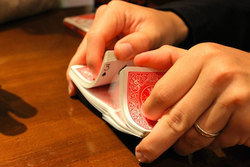Where are the aces?
 A standard deck of 52 cards is shuffled randomly, and then the cards are flipped over one-by-one. If the ace of spades is card number
and the ace of hearts is card number
, what is the expected value of
A standard deck of 52 cards is shuffled randomly, and then the cards are flipped over one-by-one. If the ace of spades is card number
and the ace of hearts is card number
, what is the expected value of
This section requires Javascript.
You are seeing this because something didn't load right. We suggest you, (a) try
refreshing the page, (b) enabling javascript if it is disabled on your browser and,
finally, (c)
loading the
non-javascript version of this page
. We're sorry about the hassle.
Since the deck is shuffled randomly, a card is equally likely to be in any of the positions. Therefore the probability P ( S = i ) = 5 2 1 and similarly P ( H = i ) = 5 2 1 for all 1 ≤ i ≤ 5 2 .
We see that the E [ S ] = E [ H ] = i = 1 ∑ 5 2 i ⋅ 5 2 1 = 2 6 . 5 . Using linearity of expectation ,
E [ S + H ] = E [ S ] + E [ H ] = 5 3 □